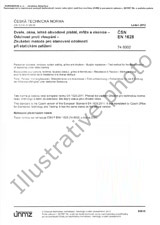We need your consent to use the individual data so that you can see information about your interests, among other things. Click "OK" to give your consent.
ČSN EN ISO 14851 (640510)
Determination of the ultimate aerobic biodegradability of plastic materials in an aqueous medium - Method by measuring the oxygen demand in a closed respirometer
Translate name
STANDARD published on 1.10.2019
The information about the standard:
Designation standards: ČSN EN ISO 14851
Classification mark: 640510
Catalog number: 507888
Publication date standards: 1.10.2019
SKU: NS-971960
The number of pages: 40
Approximate weight : 120 g (0.26 lbs)
Country: Czech technical standard
Category: Technical standards ČSN
The category - similar standards:
Annotation of standard text ČSN EN ISO 14851 (640510):
This document specifies a method, by measuring the oxygen demand in a closed respirometer, for the determination of the degree of aerobic biodegradability of plastic materials, including those containing formulation additives. The test material is exposed in an aqueous medium under laboratory conditions to an inoculum from activated sludge.
If an unadapted activated sludge is used as the inoculum, the test simulates the biodegradation processes which occur in a natural aqueous environment; if a mixed or pre-exposed inoculum is used, the method is used to investigate the potential biodegradability of a test material.
The conditions used in this document do not necessarily correspond to the optimum conditions allowing maximum biodegradation to occur, but this document is designed to determine the potential biodegradability of plastic materials or give an indication of their biodegradability in natural environments.
The method enables the assessment of the biodegradability to be improved by calculating a carbon balance (optional, see Annex E).
The method applies to the following materials.
- Natural and/or synthetic polymers, copolymers or mixtures thereof.
- Plastic materials which contain additives such as plasticizers, colorants or other compounds.
- Water-soluble polymers.
- Materials which, under the test conditions, do not inhibit the microorganisms present in the inoculum. Inhibitory effects can be determined using an inhibition control or by another appropriate method (see, for example, ISO 8192[2]). If the test material is inhibitory to the inoculum, a lower test concentration, another inoculum or a pre-exposed inoculum can be used
Preview of the standard ČSN EN ISO 14851 (640510)
We recommend:
Technical standards updating
Do you want to make sure you use only the valid technical standards?
We can offer you a solution which will provide you a monthly overview concerning the updating of standards which you use.
Would you like to know more? Look at this page.




 Cookies
Cookies
